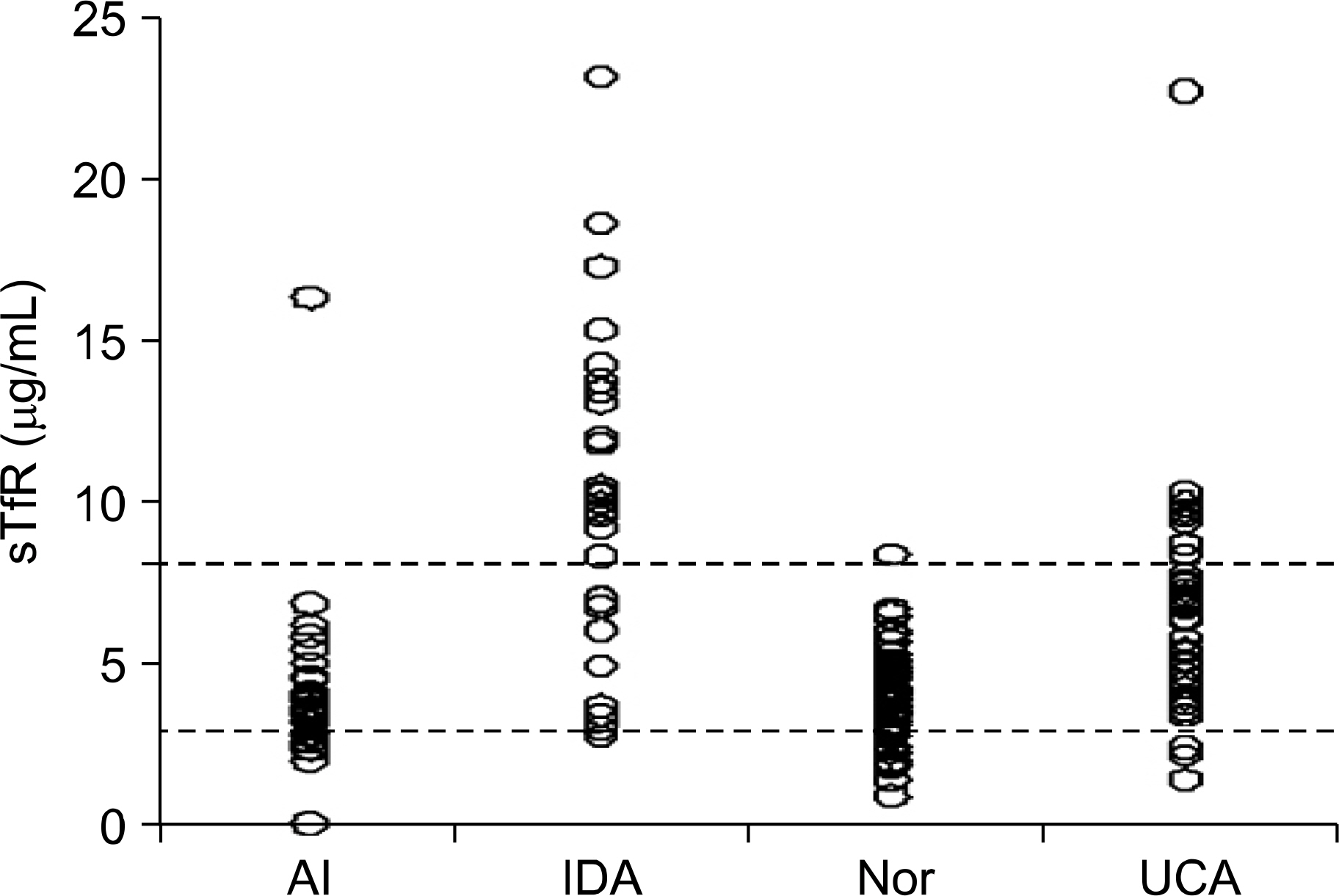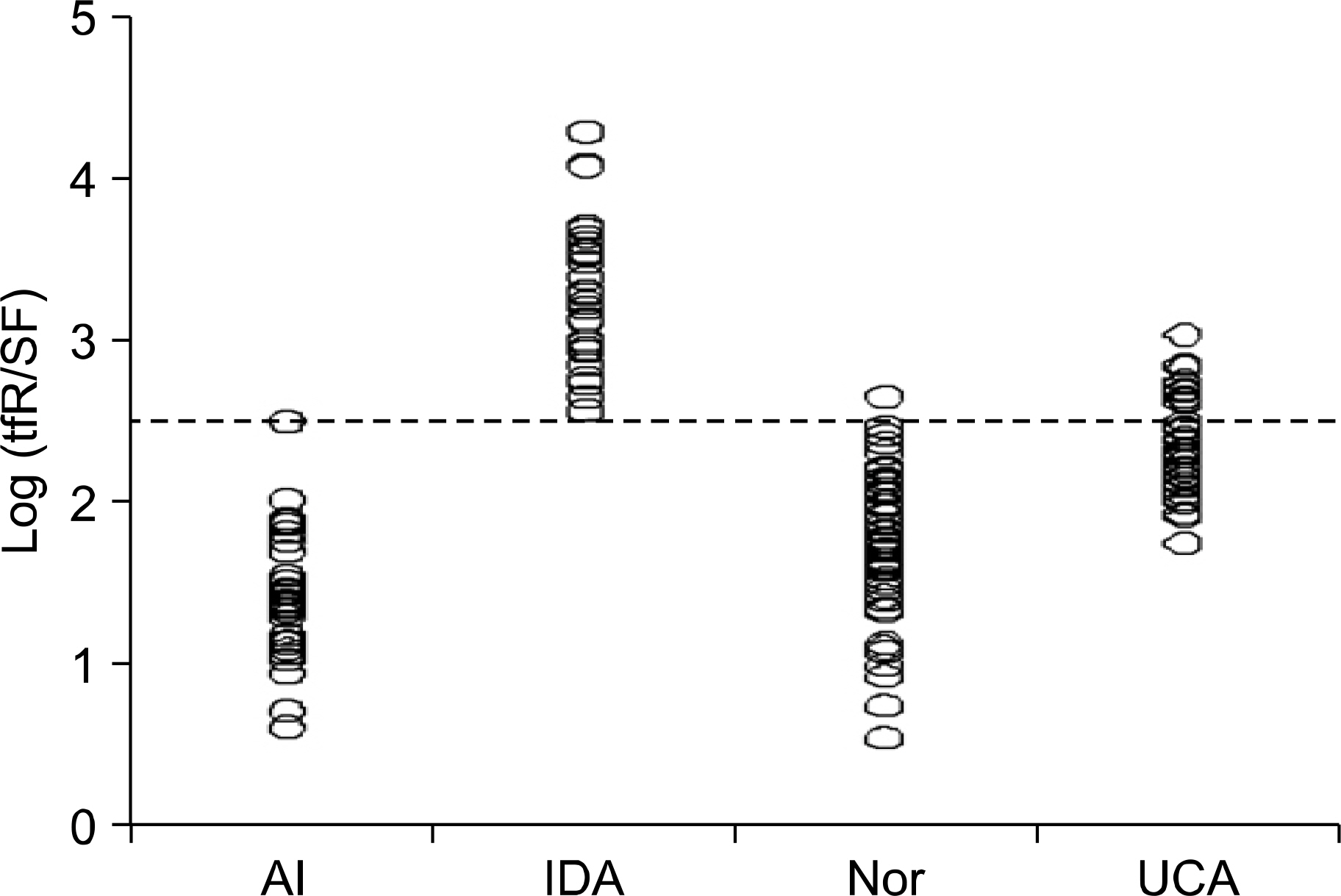Korean J Hematol.
2008 Mar;43(1):28-33. 10.5045/kjh.2008.43.1.28.
The Usefulness of the Serum Transferrin Receptor to Serum Ferritin Ratio for Discriminating between Iron Deficiency Anemia and Anemia of Inflammation in Infants
- Affiliations
-
- 1Department of Pediatrics, Gyeongsang National University College of Medicine, Jinju, Korea. Pedneu@gsnu.ac.kr
- 2Department of Diagnostic Laboratory, Gyeongsang National University College of Medicine, Jinju, Korea.
- KMID: 1485154
- DOI: http://doi.org/10.5045/kjh.2008.43.1.28
Abstract
-
BACKGROUND: The incidence of iron deficiency anaemia in infants, which is caused by the increased iron demand for rapid growth during this period, is reported to range from 10 to 40%. This age group also suffers from a number of acute illnesses (urinary tract infection, pneumonia and other viral illness). The aim of this study was to evaluate the usefulness of soluble transferrin receptor (sTfR) values and the different methods of calculating the sTfR and serum ferritin (SF) ratio for differentiating anemia of inflammation (AI) from iron deficiency anemia (IDA) or a mixture of these two types of anemia.
METHODS
173 infants among all the infants who visited Gyeongsang National University Hospital from 2000 to 2006 were enrolled in this study. The hemoglobin (Hb), SF and sTfR values were checked and the infants were divided into the Al subgroup (Hb <11g/dL and SF > 50microgram/L), the IDA subgroup (Hb <11g/dL and SF < 12microgram/L), the normal group (Hb > or =11g/dL and SF > or =12microgram/L), and the unclassified anemia (UCA) group (Hb <11g/dL and SF 12~50microgram/L).
RESULTS
The mean sTfR and sTfR/Log SF values in the AI group were 3.89 and 10.6microgram/mL, respectively (P<0.01). These values in the IDA group were 1.9 and 36.11, respectively (P<0.01). The mean Log (sTfR/SF) was statistically significant between all the subgroups (1.35 in AI, 3.29 in IDA, 1.76 in Nor and 2.35 in UCA). All the infants in the IDA group had a Log (sTfR/SF) value >2.55 whereas all the infants classified in AI group had a Log (sTfR/SF) value <2.55.
CONCLUSION
The Log (sTfR/SF) value is a useful criterion for discriminating between AI and IDA.
Keyword
MeSH Terms
Figure
Reference
-
1). Domellof M. Iron requirements, absorption and metabolism in infancy and childhood. Curr Opin Clin Nutr Metab Care. 2007. 10:329–35.2). Beard JL. Iron biology in immune function, muscle metabolism and neuronal functioning. J Nutr. 2001. 131(2 Suppl 2):568–79.
Article3). Puntarulo S. Iron, oxidative stress and human health. Mol Aspects Med. 2005. 26:299–312.
Article4). O'Brien KO., Zavaleta N., Caulfield LE., Wen J., Abrams SA. Prenatal iron supplements impair zinc absorption in pregnant Peruvian women. J Nutr. 2000. 130:2251–5.5). Cook JD., Skikne BS., Baynes RD. Serum transferrin receptor. Annu Rev Med. 1993. 44:63–74.
Article6). Holmberg L. Soluble transferrin receptor in the diagnosis of anaemia and iron deficiency in childhood. Acta Paediatr. 2000. 89:1152–3.
Article7). Allen J., Backstrom KR., Cooper JA, et al. Measurement of soluble transferrin receptor in serum of healthy adults. Clin Chem. 1998. 44:7–9.
Article8). Mast AE., Blinder MA., Gronowski AM., Chumley C., Scott MG. Clinical utility of the soluble transferrin receptor and comparison with serum ferritin in several populations. Clin Chem. 1998. 44:45–51.
Article9). Bhaskaram P., Madhavan Nair K., Balakrishna N., Ravinder P., Sesikeran B. Serum transferrin receptor in children with respiratory infections. Eur J Clin Nutr. 2003. 57:75–80.
Article10). Kivibidila S., Warrier RP., Ode D., Yu L., Tshefu KA. Lack of difference in iron status assessed by soluble transferrin receptor between children with cerebral malaria and those with non-cerebral malaria. J Trop Pediatr. 1999. 45:166–7.11). Mockenhaupt FP., May J., Stark K., Falusi AG., Meyer CG., Bienzle U. Serum transferrin receptor levels are increased in asymptomatic and mild Plasmodium falciparum-infection. Haematologica. 1999. 84:869–73.12). Malope BI., MacPhail AP., Alberts M., Hiss DC. The ratio of serum transferrin receptor and serum ferritin in the diagnosis of iron status. Br J Haematol. 2001. 115:84–9.
Article13). Ho CH. The differential diagnostic values of serum transferrin receptor, serum ferritin and related parameters in the patients with various causes of anemia. Haematologica. 2001. 86:206–7.14). Lee JY., Lim HS. Iron status of pregnant women and evaluation of cut-off levels of Hbm Hct, TIBC, sTfR: ferritin ratio for assessment of iron deficiency. Korean J Human Ecology. 2001. 4:36–45.15). Choi JW., Nahm CH., Pai SH., Sun K., Kim SK., Hyun IY. Difference of serum transferrin receptor (sTfR) level between healthy adults and children, and correlation to serum ferritin level. Korean J Clin Pathol. 1999. 19:149–55.16). Punnonen K., Irjala K., Rajamäki A. Serum transferrin receptor and its ratio to serum ferritin in the diagnosis of iron deficiency. Blood. 1997. 89:1052–7.
Article17). Dimitriou H., Stiakaki E., Markaki EA., Bolonaki I., Giannakopoulou C., Kalmanti M. Soluble transferrin receptor levels and soluble transferrin receptor/log ferritin index in the evaluation of erythropoietic status in childhood infections and malignancy. Acta Paediatr. 2000. 89:1169–73.
Article18). Kohgo Y., Nishisato T., Kondo H., Tsushima N., Niitsu Y., Urushizaki I. Circulating transferrin receptor in human serum. Br J Haematol. 1986. 64:277–81.
Article19). Vázquez Lopez MA., Carracedo A., Lendinez F., Muñoz FJ., López J., Muñoz A. The usefulness of serum transferrin receptor for discriminating iron deficiency without anemia in children. Haematologica. 2006. 91:264–5.20). Choi JW., Pai SH., Im MW., Kim SK. Change in transferrin receptor concentrations with age. Clin Chem. 1999. 45:1562–3.
Article21). Ferguson BJ., Skikne BS., Simpson KM., Baynes RD., Cook JD. Serum transferrin receptor distinguishes the anemia of chronic disease from iron deficiency anemia. J Lab Clin Med. 1992. 119:385–90.22). Suominen P., Möttönen T., Rajamäki A., Irjala K. Single values of serum transferrin receptor and transferrin receptor ferritin index can be used to detect true and functional iron deficiency in rheumatoid arthritis patients with anemia. Arthritis Rheum. 2000. 43:1016–20.
Article
- Full Text Links
- Actions
-
Cited
- CITED
-
- Close
- Share
- Similar articles
-
- Incidenc of Iron Deficiency Anemia and Changes in Serum Feffitin Level in Various Childhood Diseases
- Correlaton between soluble transferrin receptor concentration and inflammatory markers
- The usefulness of soluble transferrin receptor in the diagnosis and treatment of iron deficiency anemia in children
- The Relationship between Helicobacter pylori Infection and Iron-Deficiency: Seroprevalence Study in 937 Pubescent Children
- Iron Deficiency Anemia in Infants and Young Children




